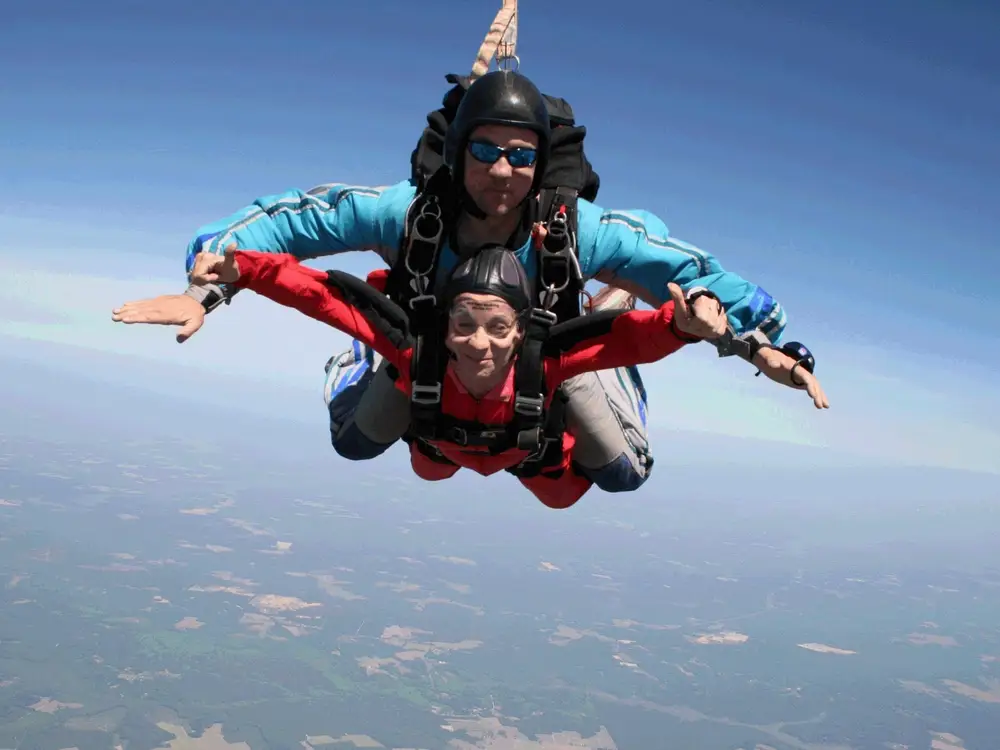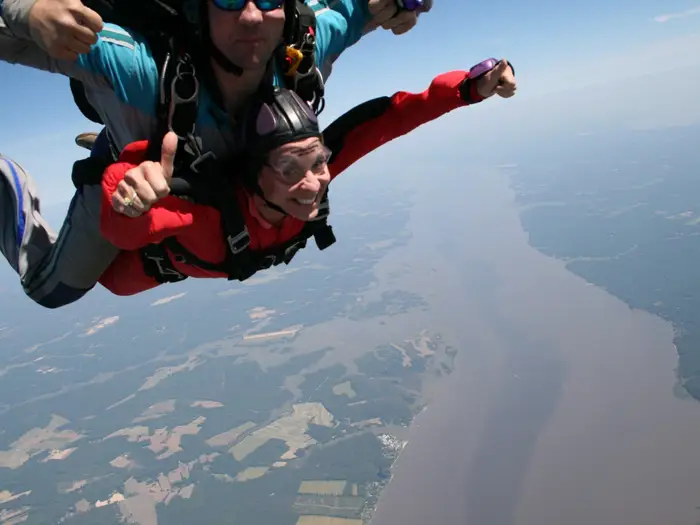I’ve always been curious to go skydiving and finally tried it at 60. I enjoyed it, but I won’t go again.

Jackie Fishman went tandem skydiving at 60 years old.
I knew some skydivers when I went to college in Buffalo, New York, in the 1970s, and I thought their exploits were fascinating, but I didn’t try it then.
Fast-forward to 60 years old, and the opportunity to satisfy my long-held interest presented itself as part of a fundraiser for a Jewish cause. When I mentioned this to my husband, he told me how unhinged he thought I was.
“Why not?” I countered, “It’s for a good cause!”
But there was no way he would accompany me, so I went with a student who was also connected with the fundraiser who made her appointment on the same day as me. No one else I knew would go with me, so this would otherwise have been a solo odyssey.
The day of the jump arrived, and I was excited but nervous
We arrived at the West Point Skydiving facility near West Point, Maryland, in the early fall morning as instructed. We were scheduled on the last flight since we were the only tandem jumpers.
For hours, we watched from the hangar on the ground as many solo jumpers went up in the propeller airplane, which had a large freight door that opened wide enough to make it easy to jump from. They were not part of the fundraiser, and several made multiple jumps, returning to the air hangar after each one to carefully refold their parachutes, a lifesaving yet mundane task.
With each successive take-off, my anxiety grew. I thought watching everyone else return safely would make me braver, but it only increased my anxiety.
Finally, it was our turn. We put on orange jumpsuits and small helmets with goggles. We were strapped to the front of the bodies of our tandem jump partners, experienced jumpers who would wear the parachutes and oversee our adventure.
We boarded the plane and took off. While flying, we watched several solo jumpers leap from the plane. Watching them jump made me feel as if I had taken leave of my senses. The joke everyone passed around was, “Why would anyone jump out of a perfectly good airplane?”
While watching, we received a quick overview of the experience. We were told we’d leave the plane backwards and bend our knees so our feet would clear the plane easily. We were also told to jump away from the plane to avoid the propellers.

Jackie Fishman was nervous to try skydiving.
Jumping out of a plane was like nothing else I’d ever done — or will do again
The recommended height for a first-time tandem jump is at least 10,000 feet to give about a minute in free fall, where you are rushing toward Earth before you need to deploy the parachute. My jump was at around 12,000 feet.
We left the plane and did a backward flip, and immediately, the force of the air caused my cheeks to flap and flatten against the sides of my face in the rushing wind. Was this because I was 60 years old, or is it something that happens to all jumpers? The feeling was odd and made me feel like a slack-faced hound dog.
I had retained the sky diving company’s photographer to take photos, and he jumped before us with his camera mounted on his helmet. He took pictures and video as we rocketed toward Earth.

Jackie Fishman understands why people enjoy skydiving.
The rushing air prevented me from looking down at the approaching ground. Instead, I looked at the photographer who was falling close to us. I made the thumbs-up sign with both hands for the purpose of the photos and then realized I couldn’t change my gesture as my hands were frozen in place by fear. We continued to rush closer to earth until the time to pull the parachute. My tandem buddy offered to let me pull it, but I declined (what if I messed up?!).
As soon as the parachute deployed, we were yanked up. Then we gently floated like a newly fallen leaf, swaying and bobbing. For the first time, I marveled at the scenery and the elevation and finally enjoyed the ride. We looked out at Chesapeake Bay and the green trees and earth and small houses and fields. It was peaceful and I finally understood the reason people jumped repeatedly. It made sense.
Sticking the landing is important, and my tandem buddy gave me some pointers as we floated toward the ground. You want to land on the balls of your feet, bend your knees and do a little run. Our landing was perfect despite a stronger-than-desired wind.
Shortly after we landed, I saw one of the solo jumpers land. They were swept up by the wind and landed on their head. Since it was a head injury, they were instructed not to move until an ambulance came to check them, but the paramedics determined they were OK. Seeing this situation, I realized how many natural and unpredictable forces can affect the success of a jump.
Would I do it again? I can safely say, “I am one and done.” But I’m glad I did it!






